
Independence of India: A Detailed Introduction
India’s struggle for independence was a historic journey in which millions of people devoted their lives. India gained independence from British rule on 15 August 1947. This struggle lasted for almost 200 years and involved many revolutionary movements , non-violent protests and sacrifices.
Beginning of British rule
In 1757 Battle of Plassey After winning, the British East India Company laid the foundation of rule in India. In 1857 , the first freedom struggle took place in India , which is called the “Revolt of 1857 “. Even though it was not successful , it ignited the spark of freedom movement in India.
Major phases of the freedom struggle
1. Revolt of 1857 (First War of Independence)
- This is known as the first independence struggle of India.
- Mangal Pandey , Rani Lakshmibai of Jhansi , Nana Saheb , Tatya Tope and Bahadur Shah Zafar.
- This rebellion failed , but it awakened the consciousness of independence in the Indian society.
- After this the British government took direct control of India.
2. Indian National Congress ( INC) and early movements
- In 1885 Indian National Congress was established.
- In the initial phase the Congress was moderate and was demanding constitutional reforms.
- Indian Councils Act of 1892 And Morley-Minto Reforms of 1909 This was the result of this effort.
- 1905 , the “Swadeshi Movement” was launched against the partition of Bengal.
3. Revolutionary Movement ( 1900-1930)
- During this period many revolutionary organizations were formed , which fought armed struggle.
- Bhagat Singh , Chandrashekhar Azad , Batukeshwar Dutt , Khudiram Bose , Rajguru and Sukhdev Like young revolutionaries carried out bomb blasts and attacks against the British.
- Jallianwala Bagh Massacre in 1919 This happened , which further intensified the freedom struggle.
- Hindustan Socialist Republican Association ( HSRA) And Anushilan Samiti Like organizations were formed.
4. Mahatma Gandhi and non-violent movement
Mahatma Gandhi in India’s freedom struggle Nonviolence and Satyagraha Gave new direction through.
- 1920: Non-cooperation Movement – non-violent protest against the British government.
- 1930: Civil Disobedience Movement and Dandi March – protest against the Salt Law.
- 1942: Quit India Movement- ” British Quit India” slogan was given.
Under the leadership of Gandhiji, millions of Indians joined the non-violent movement and the British were forced to leave India.
Independence and Partition of India ( 1947)
- The British government became financially weak after the Second World War ( 1939-1945) .
- Cabinet Mission Plan in 1946 But no agreement was reached on the transfer of power.
- 14 August 1947 and India became independent on 15 August 1947 .
- first prime minister of india Pandit Jawaharlal Nehru And he gave a historic speech from the Red Fort – “Tryst with Destiny” .
- India became independent , but with it the country was divided , which displaced millions of people and led to communal riots.
conclusion
India’s independence was a long and hard-fought journey in which millions of people sacrificed their lives. It was not just a political independence but the beginning of a new identity and self-reliance. After independence , India adopted a democratic constitution and moved forward towards development.” Salute to the heroes of the freedom struggle , who sacrificed their lives and gave us a free India!”Independence of India: A Detailed Introduction
India’s struggle for independence was a historic journey in which millions of people devoted their lives. India gained independence from British rule on 15 August 1947. This struggle lasted for almost 200 years and involved many revolutionary movements , non-violent protests and sacrifices.
Beginning of British rule
In 1757 Battle of Plassey After winning, the British East India Company laid the foundation of rule in India. In 1857 , the first freedom struggle took place in India , which is called the “Revolt of 1857 “. Even though it was not successful , it ignited the spark of freedom movement in India.
Major phases of the freedom struggle
1. Revolt of 1857 (First War of Independence)
- This is known as the first independence struggle of India.
- Mangal Pandey , Rani Lakshmibai of Jhansi , Nana Saheb , Tatya Tope and Bahadur Shah Zafar.
- This rebellion failed , but it awakened the consciousness of independence in the Indian society.
- After this the British government took direct control of India.
2. Indian National Congress ( INC) and early movements
- In 1885 Indian National Congress was established.
- In the initial phase the Congress was moderate and was demanding constitutional reforms.
- Indian Councils Act of 1892 And Morley-Minto Reforms of 1909 This was the result of this effort.
- 1905 , the “Swadeshi Movement” was launched against the partition of Bengal.
3. Revolutionary Movement ( 1900-1930)
- During this period many revolutionary organizations were formed , which fought armed struggle.
- Bhagat Singh , Chandrashekhar Azad , Batukeshwar Dutt , Khudiram Bose , Rajguru and Sukhdev Like young revolutionaries carried out bomb blasts and attacks against the British.
- Jallianwala Bagh Massacre in 1919 This happened , which further intensified the freedom struggle.
- Hindustan Socialist Republican Association ( HSRA) And Anushilan Samiti Like organizations were formed.
4. Mahatma Gandhi and non-violent movement
Mahatma Gandhi in India’s freedom struggle Nonviolence and Satyagraha Gave new direction through.
- 1920: Non-cooperation Movement – non-violent protest against the British government.
- 1930: Civil Disobedience Movement and Dandi March – protest against the Salt Law.
- 1942: Quit India Movement- ” British Quit India” slogan was given.
Under the leadership of Gandhiji, millions of Indians joined the non-violent movement and the British were forced to leave India.
Independence and Partition of India ( 1947)
- The British government became financially weak after the Second World War ( 1939-1945) .
- Cabinet Mission Plan in 1946 But no agreement was reached on the transfer of power.
- 14 August 1947 and India became independent on 15 August 1947 .
- first prime minister of india Pandit Jawaharlal Nehru And he gave a historic speech from the Red Fort – “Tryst with Destiny” .
- India became independent , but with it the country was divided , which displaced millions of people and led to communal riots.
conclusion
India’s independence was a long and hard-fought journey in which millions of people sacrificed their lives. It was not just a political independence but the beginning of a new identity and self-reliance. After independence , India adopted a democratic constitution and moved forward towards development.” Salute to the heroes of the freedom struggle , who sacrificed their lives and gave us a free India!”
Beginning of British Rule
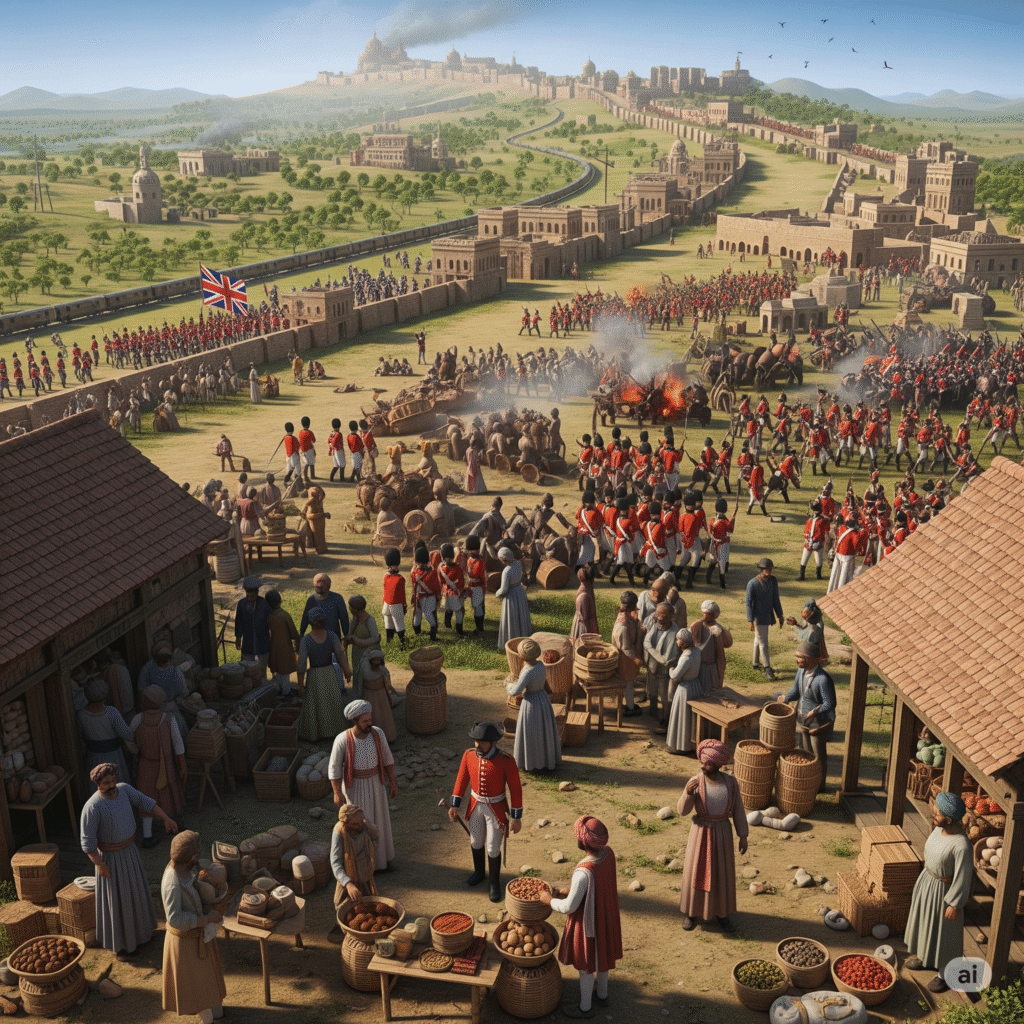
Beginning of British Rule: A Detailed Study
Role
British rule in India began in the 17th century under the pretext of trade , but gradually it turned into political and military control. The British East India Company increased its influence by subduing Indian kingdoms and finally India became part of the British Empire in 1858 .
Arrival of the East India Company ( 1600-1757)
1. Establishment of the East India Company ( 1600)
- Queen of England on 31 December 1600 elizabeth first Allowed the East India Company to trade in India.
- The main objective of the company was to buy and sell spices , cotton textiles , silk and other commercial goods.
2. First Steps in India ( 1608-1612)
- The first British merchant ship in 1608 Appearance Arrived at the port.
- in 1612 Jahangir Allowed the British to carry on trade in Surat.
- in 1615 Sir Thomas Roe Obtained special trading rights in the Mughal court.
3. Early trading centers
- in 1639 Madras (Chennai) The first British fort ” Fort St. George ” was built in 1725.
- in 1668 Bombay (Mumbai) It was acquired from the Portuguese and came under British rule.
- In 1690 Kolkata Trade began in 1696 and ” Fort William ” was built.
Expansion of British power ( 1757–1857)
1. Battle of Plassey ( 1757) – Foundation of British rule
- Nawab of Bengal Siraj-ud-Daulah There was a fight between the British and the East India Company.
- British General robert clive Won the war by bribing the rich merchants of Bengal (Mir Jafar).
- outcome: The East India Company got the right to rule Bengal.
2. Battle of Buxar ( 1764) – Capture of complete power
- In this war the British army Mir Qasim (Bengal) , Shuja-ud-Daula (Awadh) and Shah Alam II (Mughal Emperor) Defeated.
- In 1765 Allahabad Treaty Under this, the company got the Diwani (revenue collection) of Bengal , Bihar and Orissa.
East India Company’s complete control over India ( 1765-1857)
1. Establishment of British administration
- In 1773 Regulating Act was brought and Warren Hastings Became the first Governor-General.
- in 1793 permanent settlement policy was implemented , which gave the landlords the right to collect taxes.
2. Expansionist policies
- 1818: Third Anglo-Maratha War – Defeat of the Marathas and expansion of British power in India.
- 1849: Second Anglo-Sikh War – Punjab came under British rule.
- Doctrine of Lapse – By 1856 many Indian princely states (Jhansi , Satara , Nagpur) were annexed to the British Empire.
🔹 Revolt of 1857 : End of British rule and beginning of direct rule
- 1857 the soldiers and common people of India revolted against the British rule.
- Mangal Pandey , Rani Lakshmibai of Jhansi , Bahadur Shah Zafar , Tatya Tope and Nana Saheb fought.
- This rebellion failed , but the British government ended the rule of the East India Company.
Rule of the British Crown ( 1858 to 1947)
- In 1858 queen victoria India became part of the British Empire under the “Government of India Act” of 1837.
- In 1877 Queen Victoria was declared the Empress of India.
- thereafter in india The title of Governor-General was changed to “Viceroy” was changed to.
conclusion
British rule came to India in the name of trade , but gradually they took over India. Battle of Plassey, 1757 It was the beginning of British rule and Direct rule of the British Government in 1858 After this, India remained under the British Crown until 1947 .” This period of British rule was extremely difficult for India , but this struggle also ignited the spark of the freedom struggle.”
Major phases of India’s freedom struggle
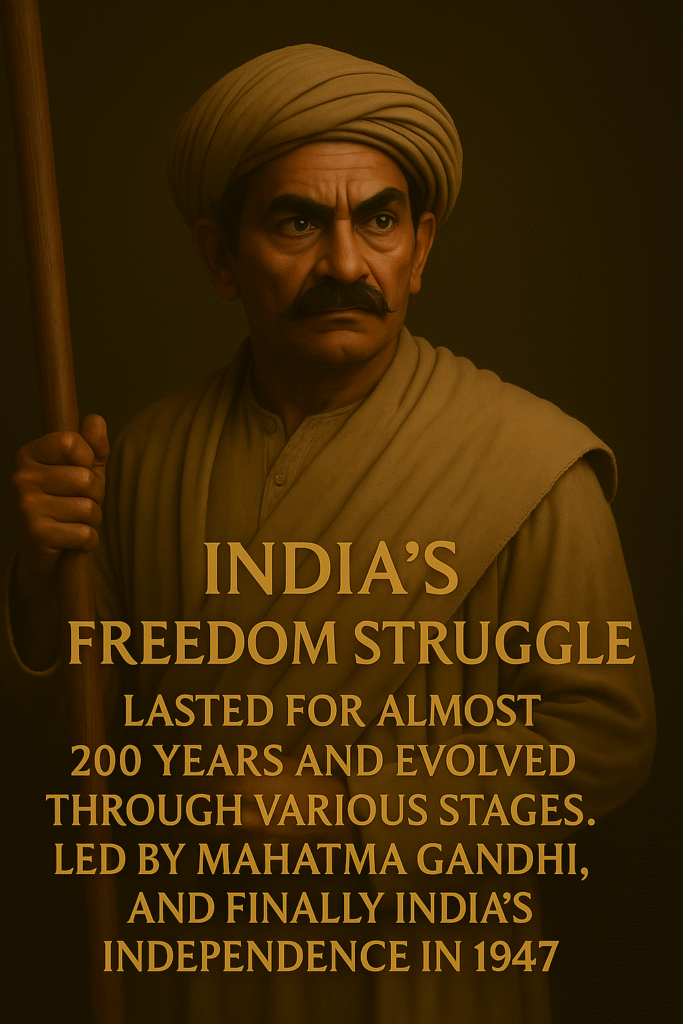
India’s freedom struggle lasted for almost 200 years and evolved through various stages. It included initial discontent , revolutionary movements , non-violent struggle led by Mahatma Gandhi, and finally India’s independence in 1947 .
🔹1 . Early War of Independence ( 1757-1857)
1.1 Battle of Plassey ( 1757) and Battle of Buxar ( 1764)
- In 1757 Battle of Plassey In which the British defeated Siraj-ud-Daula, the Nawab of Bengal, and established their power.
- In 1764 Battle of Buxar Which gave the East India Company control over Bengal , Bihar and Orissa.
1.2 First War of Independence of 1857
- is also called “Sepoy Mutiny” or ” Revolt of 1857 “.
- Main Leader- Mangal Pandey , Rani Lakshmibai of Jhansi , Tatya Tope , Nana Saheb , Bahadur Shah Zafar .
- This rebellion was unsuccessful , but it strengthened the spirit of independence among Indians.
- Result: In 1858 the British Government ended the rule of the East India Company and India came under the direct control of the British Crown.
🔹 2. Beginning of organized national movement ( 1885-1919)
2.1 Establishment of the Indian National Congress ( 1885)
- A. O. Hume Founded the Indian National Congress ( INC) in 1885 .
- Initially the objective of the Congress was to demand constitutional reforms from the British government.
2.2 Partition of Bengal and Swadeshi Movement ( 1905-1911)
- In 1905 lord curzon Partitioned Bengal , which caused anger among Indians.
- Swadeshi Movement Started – Foreign clothes were boycotted and Indian clothes were adopted.
- Bal Gangadhar Tilak , Lala Lajpat Rai and Bipin Chandra Pal ( Lal-Bal-Pal) were the main leaders of this movement.
2.3 Revolutionary Movement ( 1907-1930)
- Indian youth took up arms against the British government.
- Bhagat Singh , Chandrashekhar Azad , Khudiram Bose , Batukeshwar Dutt , Rajguru , Sukhdev Like the revolutionaries challenged the British power.
- in 1919 Jallianwala Bagh Massacre It happened in which General Dyer opened fire on unarmed people.
🔹 3. Freedom struggle under the leadership of Mahatma Gandhi ( 1919-1947)
3.1 Non-cooperation Movement ( 1920-1922)
- After the Jallianwala Bagh massacre Mahatma Gandhi called for non-violent protest.
- The people Boycott of foreign clothes , government jobs and schools Did.
- In 1922 Chauri Chaura incident Due to this Gandhiji withdrew the movement.
3.2 Civil Disobedience Movement and Dandi March ( 1930)
- Lavington Treaty ( 1929) After that Gandhiji Salt Law Did “Dandi March” against.
- Millions of Indians participated in this movement and broke the laws of the British government.
3.3 Quit India Movement ( 1942)
- Gandhiji during the Second World War ” British Quit India” Gave the slogan of.
- Millions of Indians were put in jail , but the movement did not weaken.
- This was the last major movement of the freedom struggle.
🔹 4. Independence and Partition of India ( 1947)
- In 1946 Cabinet Mission Plan But no agreement was reached on the transfer of power.
- On 14 August 1947 pakistan came into being And on 15 August 1947 , India became independent.
- Pandit Jawaharlal Nehru Became the first Prime Minister of independent India.
conclusion
India’s freedom struggle went through many phases and countless people sacrificed their lives in it. It was not just a political battle , but it was also a political struggle. National renaissance and self-reliance After independence, India adopted a democratic constitution and moved forward on the path of development.” Salute to the heroes of the freedom struggle , who sacrificed their lives and gave us a free India!”
1. The Revolt of 1857 (First War of Independence)
🔹 Revolt of 1857 : India’s First War of Independence
Introduction
1857 was the first organised effort of the Indian freedom struggle , which ” India’s First War of Independence” , ” Sepoy Rebellion” Or ” The Great War of 1857″ It is also called the Revolt of 1918. This revolt was the result of atrocities by the British East India Company , socio-religious interference , economic exploitation and soldier discontent.
This revolt spread throughout North India , but the British government suppressed it in 1858. However , this revolt strengthened the spirit of independence among the Indian people and laid the foundation for the future freedom struggle.
🔹Main reasons for the revolt of 1857
1. Political reasons
- The British government ” Doctrine of Lapse “ Under this , if a king did not have an heir , his kingdom would come under the control of the British.
- Because of this Jhansi (Rani Lakshmi Bai) , Satara , Nagpur , Awadh (Nawab Wajid Ali Shah) and many other states came under the control of the British.
- Mughal Emperors Bahadur Shah Zafar He was declared the last king of Delhi and his descendants were ordered to be removed from Delhi.
2. Social and religious reasons
- The British government started interfering in the traditions and religious sentiments of Indian society.
- Sati system , child marriage prohibition on and Foreign education policy This increased discontent among the Indians.
- Christian missionaries were encouraged , which made people feel that the British wanted to convert them.
3. Economic reasons
- The economic policies of the British ruined Indian farmers , artisans and traders.
- Zamindari system and heavy taxation system Due to this the farmers started sinking into debt.
- British policies led to the decline of Indian artisans and industries , leading to increased unemployment.
4. Soldier discontent
- The Indian soldiers low pay And they got inferior level facilities in comparison to the British.
- Greased cartridges at Barrackpore (Mangal Pandey) The issue of bullets arose. These cartridges had to be bitten before use , and it was rumoured that they contained Cow and pig fat Which hurt the religious sentiments of both Hindu and Muslim soldiers.
Beginning of the revolt and major centers
📍 1. Meerut ( 10 May 1857) – Beginning of the revolt
- On May 9 , 1857 When 85 Indian soldiers refused to use greased cartridges , they were jailed by the British authorities.
- Next day On May 10, 1857 In Meerut, troops attacked the prison, freeing Indian prisoners and killing British officers.
- Thereafter the rebels Proceed towards Delhi .
📍 2. Delhi – Leadership of Bahadur Shah Zafar
- May 11, 1857 the rebels captured Delhi and Mughal Emperor Bahadur Shah Zafar was declared the leader of India.
- Delhi became the centre of the revolt , but the British recaptured Delhi in September 1857 .
- Bahadur Shah Zafar was arrested and sent to Rangoon (Myanmar) , where he died in 1862 .
📍 3. Kanpur – Leadership of Nana Saheb
- Nana saheb Led the revolt in Kanpur.
- their commander Tatya Tope He fought hard against the British but ultimately the British captured Kanpur.
- Tatya Tope was captured and hanged in 1859 .
📍 4. Jhansi – Struggle of Rani Lakshmi Bai
- Rani Lakshmibai of Jhansi fought valiantly to save her kingdom from the British.
- 1858 , the British attacked Jhansi and Lakshmibai attained martyrdom.
- Her famous slogan was – “I will not give away my Jhansi!”
📍 5. Bihar – Kunwar Singh’s rebellion
- In Bihar Veer Kunwar Singh revolted against British rule.
- He fought till the last moment, taking on the British.
Lucknow – Leadership of Begum Hazrat Mahal
- In Awadh Begum Hazrat Mahal revolted against the British forces.
- She gave a tough fight to the British forces , but was eventually defeated and retreated to Nepal.
🔹 Suppression of the revolt of 1857 and reasons for its failure
1. Suppression of the rebellion
- September 1857 the British Delhi was captured again .
- 1858, the British forces crushed the rebellion in Kanpur , Jhansi , Lucknow and Bihar.
- to Bahadur Shah Zafar Nana Saheb was sent to Rangoon Tatya Tope has disappeared was hanged and Rani Lakshmibai She attained martyrdom in the war .
2. Reasons for the failure of the revolt
- Lack of organisation: The rebellion occurred locally , but there was no united leadership.
- Military inequality: The British army had better weapons and tactics.
- Lack of modern communication: The rebels had no strong communications system.
- Indifference of some States: Many kings of Punjab , Rajputana and Madras were with the British.
🔹 Results and effects of the revolt of 1857
1. Direct rule of the British Government ( 1858)
- 1858 the British government abolished the rule of the East India Company and Came under the British Crown .
- The title of Governor-General was changed to “Viceroy” and the first viceroy Lord Canning Made.
2. Changes in the Indian Army
- Changes were made in the recruitment of Indian soldiers and Breaking the Hindu-Muslim unity The policy was adopted.
- Indians were kept away from higher positions in the army.
3. Development of the feeling of nationalism among the Indian people
- This revolt may have failed , but it created a great deal of tension among the Indians. spirit of nationalism and independence was strengthened.
- 1857 was a major part of the Indian freedom struggle The first spark , which gave India independence in 1947 .
conclusion
of 1857 The revolt was the first major attempt of India’s freedom struggle. Although this organized revolution failed , it forced the British to change their policies and laid the foundation of the Indian National Movement.
“The War of 1857 was not just a rebellion , but it was the beginning of Indian Independence!”
2. Indian National Congress ( INC) and the early movement
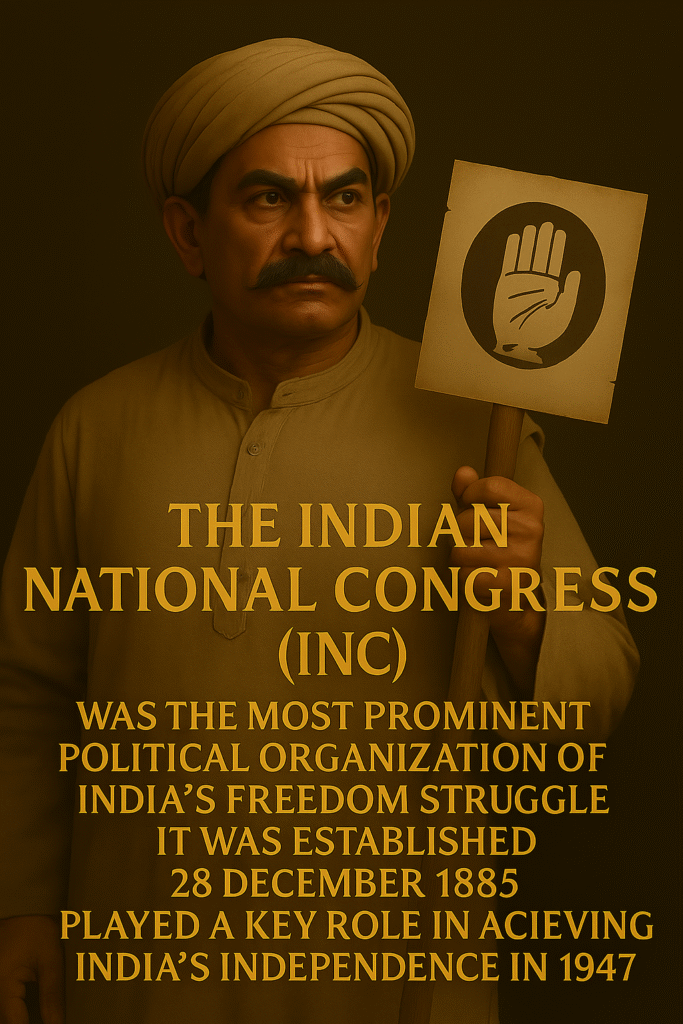
Indian National Congress ( INC) and early movements
Introduction to Indian National Congress ( INC)
The Indian National Congress ( INC) was the most prominent political organization of India’s freedom struggle. It was established 28 December 1885 The INC led political movements against the British government during the freedom struggle and played a key role in achieving India’s independence in 1947 .
Establishment of the Indian National Congress
1. Purpose of establishment
- The Indians have a Political platform render.
- from the British Government constitutional reforms To demand for.
- In India Democratic ideology To promote.
- between the Indians and the British cordial relations Make
2. How was the Indian National Congress established ?
- A. O. Hume ( Allan Octavian Hume) , a retired British officer , played an important role in the founding of the Congress.
- He served as a mediator between the British Government and Indian leaders medium of communication He suggested the establishment of a Congress to create the new government.
- The first session of the Indian National Congress was held in Bombay (Mumbai) on 28 December 1885 , presided over by Vyomesh Chandra Banerjee It was done by.
3. Prominent leaders of the first session of the Congress ( 1885)
- A. O. Hume ( Founder)
- Vyomesh Chandra Banerjee ( first president)
- Dadabhai Naoroji
- Surendranath Banerjee
- Badruddin Tayyabji
- Gopal Krishna Gokhale
- Pherozeshah Mehta
The Early Congress and its Movement ( 1885–1905)
1. Early Congress Policy ( 1885-1905) – Moderate Era
Early years of the Indian National Congress Constitutional reforms and dialogue with the British government It was focused on ” Moderate Era” It is said.
The main demands:
- The Indians Opportunities in Government Jobs should be given.
- The British Government wanted the Indians Right to self -government Give.
- imposed on Indians Heavy taxes should be abolished .
- Indians should be appointed to high positions in the judiciary and administration.
Key leaders:
- Dadabhai Naoroji – He opposed the economic policies of the British rule and ” Drain of Wealth Theory” Presented it.
- Gopal Krishna Gokhale – He was a moderate leader and adopted the policy of dialogue with the British government.
- Firozshah Mehta and Surendranath Banerjee – They demanded rights for Indians.
🔹 1905-1919: Congress split and Swadeshi movement
1. Partition of Bengal and Swadeshi Movement ( 1905-1911)
- 1905 , Lord Curzon partitioned Bengal .
- against this division Swadeshi Movement It started.
- Boycott of foreign cloth and British goods to be done.
- National education movement It started.
- The main leaders of this movement were – Lal-Bal-Pal (Lala Lajpat Rai , Bal Gangadhar Tilak , Bipin Chandra Pal) .
2. Split in Congress ( 1907) – Moderates and Extremists
- 1907 , the Congress split into two factions:
- Moderates: Gopalkrishna Gokhale , Ferozeshah Mehta , Dadabhai Naoroji.
- Extremists: Bal Gangadhar Tilak , Lala Lajpat Rai , Bipin Chandra Pal.
- extremist leader against british government adopting revolutionary methods Was in favor of.
3. 1916 – Lucknow Pact
- An agreement was reached between the Congress and the Muslim League , in which both of them together agreed to a compromise with the British Government constitutional reforms demanded for it.
- The main role behind this Bal Gangadhar Tilak and Jinnah I had done.
🔹 1919-1947: National Movement under the leadership of Mahatma Gandhi
In the Indian freedom struggle after 1919 Leadership of Mahatma Gandhi It became important.
1. Rowlatt Act and Jallianwala Bagh Massacre ( 1919)
- Rowlatt Act Under this, Indians could be sent to jail without trial.
- On 13 April 1919 General Dyer in Jallianwala Bagh (Amritsar) Bullets were fired on unarmed Indians .
2. Non-cooperation Movement ( 1920-1922)
- Mahatma Gandhi Non-violent movement started the.
- from people Boycott of foreign clothes , government jobs and British institutions Appealed to do so.
- In 1922 Chauri Chaura incident After this Gandhiji withdrew the movement.
3. Civil Disobedience Movement ( 1930) – Dandi March
- Gandhiji said Salt Satyagraha (Dandi March) and protested against the British Salt Law.
- Millions of Indians participated in this movement.
4. Quit India Movement ( 1942)
- 8 August 1942 , Gandhiji started the “Quit India” movement .
- Gandhiji and many Congress leaders He was arrested .
- This movement proved to be the final struggle for India’s independence.
5. Independence of India ( 1947)
- India became independent on 15 August 1947 .
- Congress leaders Pandit Jawaharlal Nehru Became the first Prime Minister of independent India.
conclusion
The Indian National Congress ( INC ) From constitutional reforms to freedom struggle Many important movements were carried out. In the beginning this organisation Dialogue and reforms followed the policy of , but later Non-violent movements led by Mahatma Gandhi Independence was achieved through.” The Indian National Congress played the most important role in freeing India from slavery.”
3. The Revolutionary Movement ( 1900-1930)
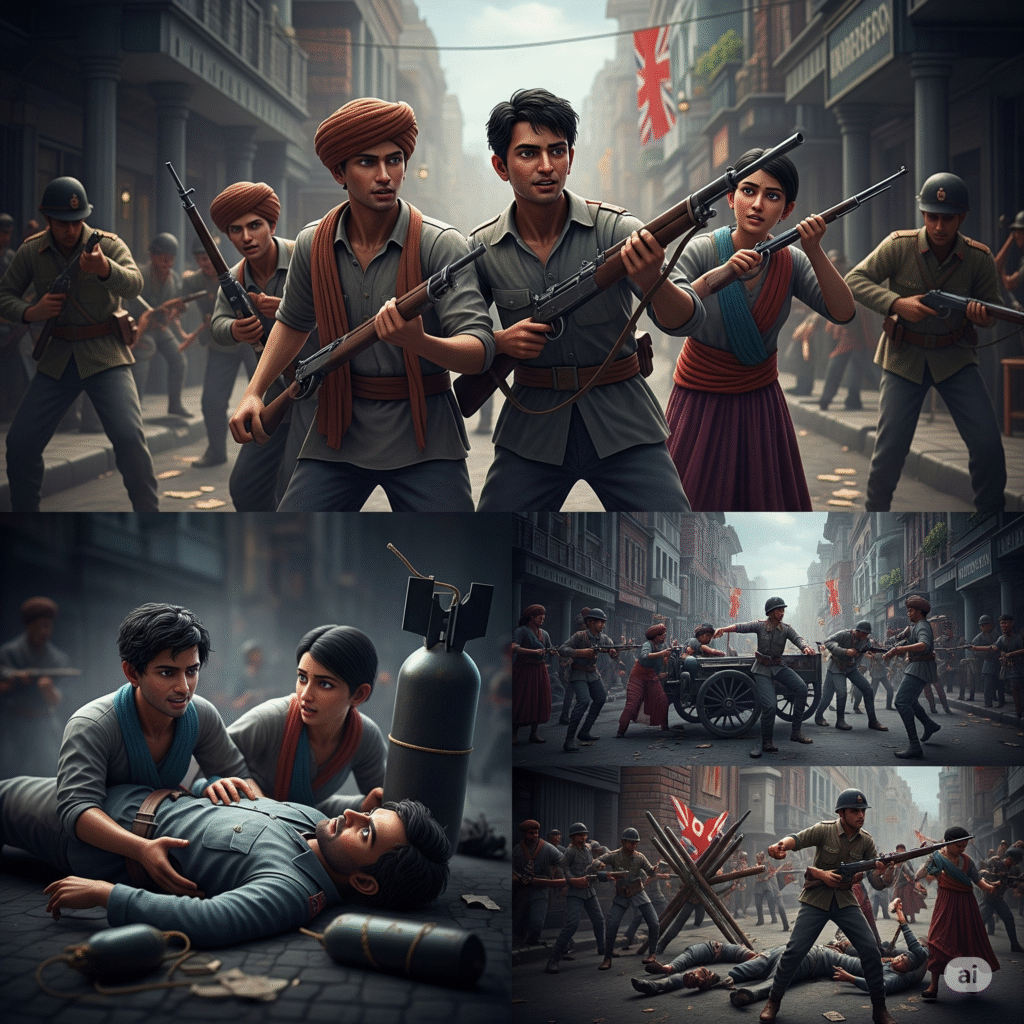
Revolutionary Movement ( 1900-1930) – Armed struggle against British rule
Introduction
1900 and 1930 , an important stream emerged in India regarding the freedom struggle , which was called Revolutionary movement It is said. Under this movement, young revolutionaries Armed struggle against British rule did and Weapons , bombs , assassinations , and armed rebellion Tried to overthrow the British through.
The aim of these revolutionary activities was to frighten the British rule , weaken the administration and create fear among the Indians. Flame of Freedom It had to be burnt.
Main reasons of revolutionary movement
1. Partition of Bengal ( 1905) and Swadeshi Movement
- In 1905 lord curzon partitioned Bengal.
- There was a massive movement against this division.
- When the non-violent movement did not yield any results , then some young revolutionaries Taking up arms got ready for it.
2. The repressive policies of the British government
- The British Government imposed restrictions on Indians Strict laws were implemented , which increased discontent.
- Rowlatt Act ( 1919) Under this, anyone could be arrested without trial.
- Jallianwala Bagh Massacre ( 1919) Inspired the youth to adopt the revolutionary path.
3. Dissatisfaction with the soft attitude of Congress
- Some Congress leaders opposed the British government Dialogue and reforms wanted independence through.
- But some young revolutionaries believed that Freedom is possible only through armed struggle .
Revolutionary activities ( 1900–1930)
📍 1. Early revolutionary organizations ( 1900-1910)
During this period many secret organizations were formed , which attacked British officials.
Major revolutionary organisations:
- Anushilan Samiti (1902, Bengal) – Prominent leaders: Prafulla Chaki , Khudiram Bose , Aurobindo Ghosh
- Yugantar Party (1906, Bengal) – Prominent leaders: Barindra Kumar Ghosh , Jatin Das
- Revolutionary Movement in Maharashtra – Important Leaders: Bal Gangadhar Tilak , Chapekar brothers
Major events:
- 1908 – Khudiram Bose and Prafulla Chaki tried to assassinate British magistrate Kingsford in Muzaffarpur.
- 1909 – Chapekar brothers murdered British officer Rand.
- 1910 – Bagha Jatin carried out many revolutionary activities.
📍 2. Ghadar Movement ( 1913-1915)
- In 1913 Ghadar Party was established , whose headquarters America and Canada I was there.
- The aim of this movement Organizing Indians living abroad to overthrow British rule Was.
- Prominent leaders: Lala Har Dayal , Kartar Singh Sarabha , Ramchandra , Baba Gurdit Singh .
- A plan was made to revolt in India in 1915 , but it was foiled by the British.
📍 3. Hindustan Republican Association ( HRA) and Kakori incident ( 1925)
- in 1924 in North India Chandrashekhar Azad , Ramprasad Bismil , Ashfaqulla Khan and Sachindranath Sanyal together with Hindustan Republican Association ( HRA) was established.
- 9 August 1925 , the Kakori train robbery occurred , in which revolutionaries looted a train full of government treasury.
- Ramprasad Bismil , Ashfaqulla Khan and Roshan Singh were hanged in 1927 .
📍 4. Bhagat Singh and the Hindustan Socialist Republican Association ( HSRA) (1928-1931)
- In 1928 Chandrashekhar Azad , Bhagat Singh , Sukhdev , Rajguru and Batukeshwar Dutt together with HRA was renamed as Hindustan Socialist Republican Association ( HSRA) kept.
- Bhagat Singh and his comrades linked the revolutionary movement with socialist ideology.
Major events:
- Opposition to Simon Commission ( 1928) –
- During the protest against Simon Commission Lala Lajpat Rai was lathi-charged , which led to his death.
- In return for Bhagat Singh , Rajguru and Sukhdev assassinated British officer Sanders in 1928 .
- Assembly Bomb Case ( 1929) –
- Bhagat Singh and Batukeshwar Dutt Bomb thrown in Delhi’s Central Assembly And he was arrested.
- Bhagat Singh , Rajguru and Sukhdev Hanged on 23 March 1931 .
📍 5. Chandrashekhar Azad and revolutionary activities ( 1930)
- After Bhagat Singh’s hanging Chandrashekhar Azad continued his revolutionary activities.
- 27 February 1931 , at Allahabad He was martyred while fighting with the British in Alfred Park.
Impact of the revolutionary movement
1. The freedom struggle gained strength
- The sacrifice of the revolutionaries increased anger against the British rule throughout the country.
2. Congress adopted a more radical policy
- Congress also became more aggressive in the push for independence in the 1930s .
3. Revolutionary spirit arose among the youth
- Bhagat Singh , Azad and other revolutionaries influenced the Indian youth.
conclusion
1900 and 1930 was an important part of the Indian freedom struggle. These brave revolutionaries ” Vande Mataram ” and ” Revolution Long Live “ Shook the British power with the slogan of.” If you want to live shamelessly then slavery is good , otherwise rebellion is better!”
4. Mahatma Gandhi and The Non-Violent Movement
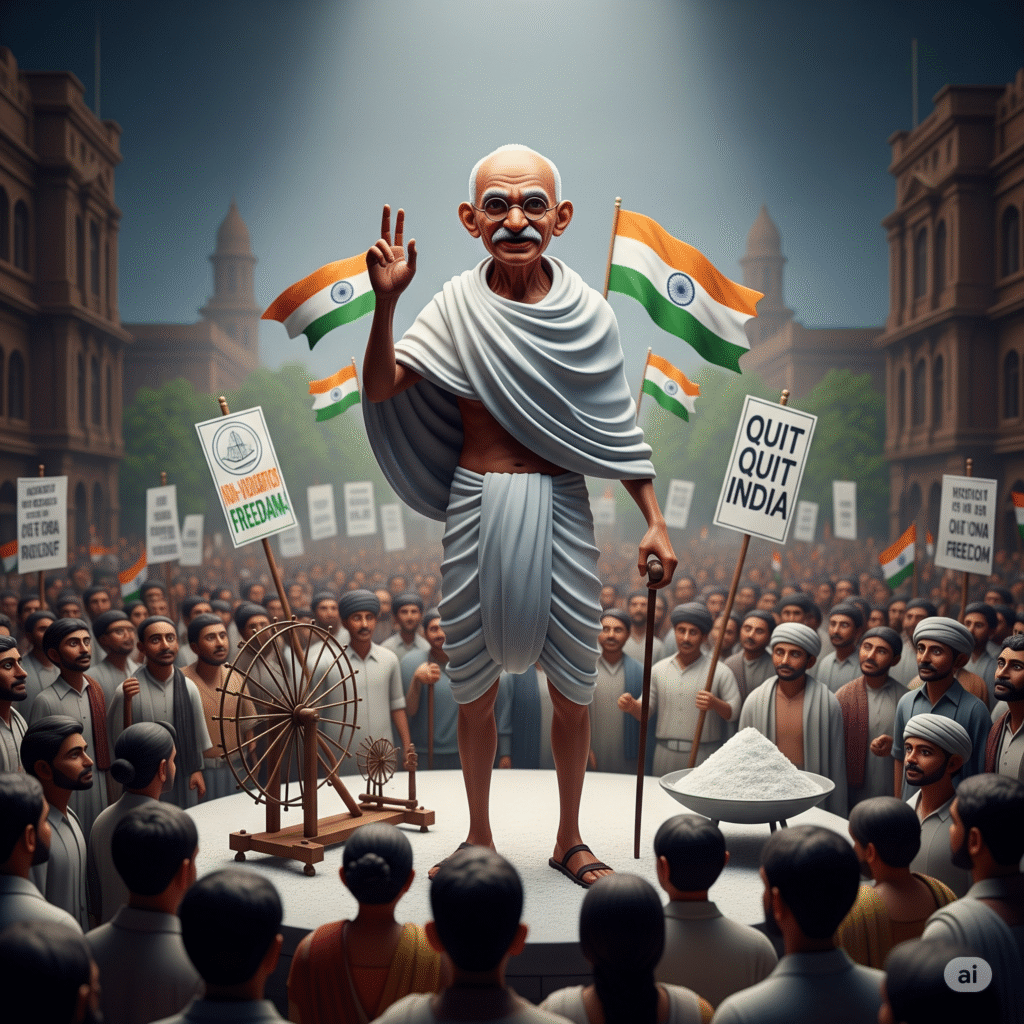
Mahatma Gandhi and the non-violent movement
Introduction
the great leader of Indian freedom struggle who Non -Violence and Satyagraha He fought against British rule through the principles of ‘Nationalism’. Three major national movements took place in India under his leadership – Non-cooperation movement ( 1920), Civil disobedience movement ( 1930) and Quit India movement ( 1942) . Gandhiji believed that violence cannot bring permanent change in the society , so he Nonviolent struggle Adopted the path of.
Biography of Mahatma Gandhi
- Full name: Mohandas Karamchand Gandhi
- Birth: 2 October 1869 , Porbandar , Gujarat
- Education: From England Studying to be a barrister ( Lawyer)
- 1893–1915: The struggle against apartheid in South Africa
- 1915: Return to India and active role in freedom struggle
Gandhiji made non-violence and Satyagraha a political weapon and used them to overthrow the British rule.
Gandhi’s major non-violent movements
📍 1. Champaran and Kheda Satyagraha ( 1917-1918)
First Satyagraha Movement In India, it occurred in Champaran (Bihar) and Kheda (Gujarat).
Champaran Satyagraha ( 1917)
- In Champaran, Bihar, farmers They were forced to cultivate indigo .
- The farmers were exploited and the British government did not compensate them.
- Gandhiji did Satyagraha Got justice for the farmers .
Kheda Satyagraha ( 1918)
- in Kheda district of Gujarat Severe famine But the British government did not stop collecting taxes .
- Gandhiji started the Satyagraha movement and finally Farmers got tax exemption .
Result: Confidence among the farmers increased and the foundation of a non-violent movement was laid.
📍 2. Non-cooperation Movement ( 1920-1922)
Reason:
- Rowlatt Act in 1919 Was passed , which allowed any Indian to be sent to jail without trial.
- Jallianwala Bagh Massacre ( 13 April 1919) General Dyer opened fire on unarmed people.
- Gandhiji protested against the British government Started the non-cooperation movement .
Major Activities:
- government jobs , schools , colleges and courts.
- Burning of foreign clothes.
- Adoption of Khadi and Swadeshi clothing.
Chauri Chaura incident ( 1922): Withdrawal of the movement
- On 5 February 1922 Chauri Chaura (Uttar Pradesh) The protesters set fire to the police station.
- 22 policemen were killed.
- Gandhiji withdrew the movement due to violence.
Result: For the first time the British government felt the organised opposition of the Indians.
📍 3. Civil Disobedience Movement ( 1930) – Dandi March
Reason:
- The British government imposed salt tax on Indians .
- Poor people could not pay tax on salt.
- Gandhiji said Started the Civil Disobedience Movement to break the British law .
Dandi March ( 12 March – 6 April 1930)
- Gandhiji said Walked 240 miles from Sabarmati Ashram (Gujarat) to Dandi (coast of the Arabian Sea) .
- going there Made salt from sea water and broke British law .
Result:
- This movement spread all over India.
- The British government Gandhiji was arrested .
- The Gandhi-Irwin Pact was signed in 1931 , which led to the release of some revolutionary leaders.
📍 4. Quit India Movement ( 1942)
Reason:
- the Second World War ( 1939-1945) the British Government gave Indians He was thrown into the war without asking anything .
- Gandhiji told the British Government Gave the slogan of ” Quit India ” .
The Quit India resolution was passed on 9 August 1942
- Gandhiji said ” Do or Die “ Gave the slogan of.
- The British government arrested all the big leaders of the Congress including Gandhiji. He was arrested .
Result:
- There were demonstrations all over India.
- in 1945 The British government decided to grant independence to India .
Gandhi’s ideas of non-violence and Satyagraha
1️ ⃣ Non -Violence: It is wrong to answer violence with violence. One should struggle peacefully for truth and justice.
2️⃣ Satyagraha : Standing against any unjust law with the power of truth and love
. 3️⃣ Swadeshi Movement: Boycott foreign clothes and adopt Indian clothes and products.
4️ ⃣ Complete independence: Self -reliant India , where every person is independent.
5️⃣ public service: Gandhiji believed that the aim of politics should be to serve the people.
Impact of Gandhiji’s movement
Unified the Indian freedom struggle.
✅ Involved the general public in the freedom struggle.
✅ Forced the British government to give independence to India.
✅ India became independent on 15 August 1947 .
conclusion
The non-violent movements led by Mahatma Gandhi gave India decisive role in securing independence He showed the world that The fight against injustice can be won through non-violence . His views are relevant even today A source of inspiration around the world Are.” Non-violence is the only religion , it is the only way of life.” – Mahatma Gandhi
Independence and Partition of India ( 1947)
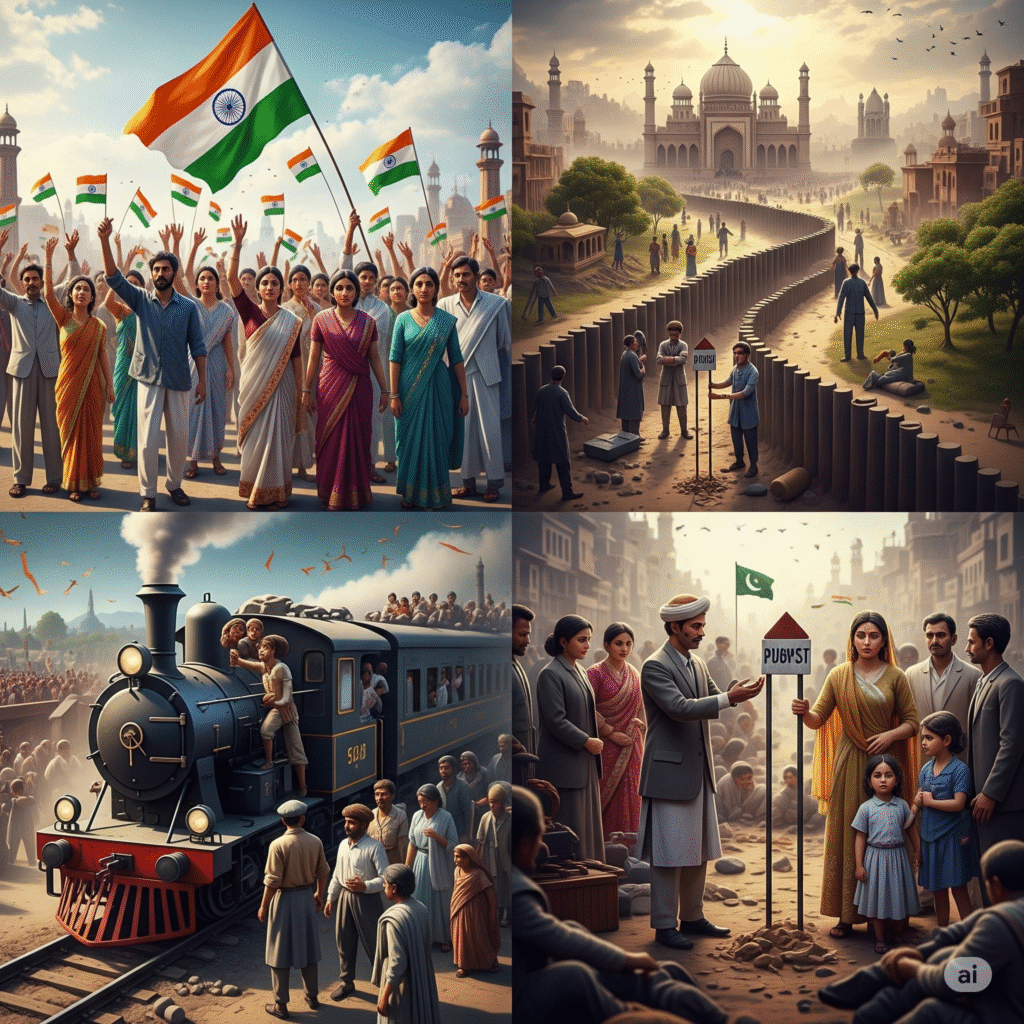
Independence and Partition of India ( 1947)
Introduction
India freed itself from British rule on 15 August 1947 We achieved independence , but this independence came with partition. A new country was created by dividing India Pakistan This division made Thousands of people were killed and millions were rendered homeless And it became one of the biggest tragedies in history. After the freedom struggle , it was a chapter that hopes and pain It was full of both.
India’s struggle for independence and the final phase ( 1940–1947)
📍 1. World War II and India ( 1939-1945)
- World War II broke out in 1939 and The British government involved the Indians in the war without their permission .
- In opposition to this The Congress cabinet resigned .
- The British did not pay heed to the demands of the Indian leaders , which further intensified the freedom struggle.
📍 2. ‘ Quit India Movement ‘ (1942) – The decisive battle for independence
- On 8 August 1942 Mahatma Gandhi called for the “Quit India ” movement .
- Gandhiji’s slogan was ” Do or Die ” ( Do or Die ) .
- arrested Gandhiji , Nehru , Patel and other leaders.
- Violence broke out throughout the country , but the movement forced the British government to bow down.
Result: The British government understood that it was no longer possible to rule India.
📍 3. Muslim League and the demand for partition
- Built in 1906 Muslim League In 1940 ” Pakistan’s Demand” of.
- Jinnah stated that Hindus and Muslims were two separate nations ( ” Two-Nation Theory” ) .
- The British government adopted the policy of “divide and rule” and promoted division.
📍 4. Cabinet Mission Plan ( 1946) and Interim Government
- In 1946 The British government sent the “Cabinet Mission” , which came up with a plan to keep India united.
- But Differences between Congress and Muslim League increased.
- On 2 September 1946 An interim government was formed under the chairmanship of Nehru .
📍 5. Reasons for Partition and Mountbatten Plan ( 1947)
- In 1947 Lord Mountbatten became the last Viceroy of India .
- He died on 3 June 1947 ” Mountbatten Plan” Which proposed the partition of India.
- Congress accepted it under compulsion because Jinnah was not ready to accept the partition without it.
- Pakistan was formed on 14 August 1947 , and India became independent on 15 August 1947 .
Consequences of Independence and Partition
📍 1. Creation of India and Pakistan
- India and Pakistan Two separate countries were formed .
- to Pakistan It was divided into two parts (West Pakistan and East Pakistan , which became Bangladesh in 1971 ) .
📍 2. Communal riots and genocide
- After the Partition Widespread violence broke out between Hindu , Muslim and Sikh communities .
- Millions of people were killed and More than 1.5 crore people became homeless .
- Delhi , Lahore , Amritsar and Noakhali.
📍 3. Assassination of Mahatma Gandhi ( 30 January 1948)
- Gandhiji was deeply saddened by the riots that took place during the partition.
- They Non-violence and communal harmony Tried to maintain it.
- January 30, 1948 , Nathuram Godse assassinated Gandhiji .
conclusion
1947 , India We got freedom from British rule , but had to pay the price of partition . The sacrifice of millions of people became the foundation of this freedom. India It adopted democracy and moved forward , while Pakistan took a different path.” India’s Independence was not just a one-day event , it is a story of thousands of sacrifices!”
Reference
Bipan Chandra, India’s Struggle for Independence (1857–1947), Penguin Books
R.C. Majumdar, History of the Freedom Movement in India
Sumit Sarkar, Modern India: 1885–1947
NCERT books Modern India (Class 8, 10, 12)
